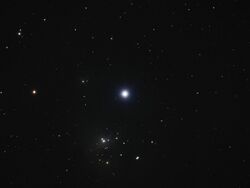Astronomy:IC 348
| IC 348 | |
|---|---|
| File:Hubble image of LRLL 54361 and its surroundings.tif Hubble image of IC 348 and its surroundings.[1] | |
| Observation data (J2000 epoch) | |
| Constellation | Perseus |
| Right ascension | 03h 44m 34s[2] |
| Declination | +32° 09.8′[2] |
| Distance | 1,028 ly (315 pc)[3] |
| Apparent magnitude (V) | 7.3[2] |
| Physical characteristics | |
| Estimated age | 2 million years |
| Other designations | C 0341+321, Collinder 41 |

IC 348 is a star-forming region in the constellation Perseus located about 1,000 light years from the Sun. It consists of nebulosity and an associated 2-million-year-old cluster of roughly 400 stars within an angular diameter of 20″. The most massive stars in the cluster are the binary star system BD+31°643, which has a combined spectral class of B5.[3] Based upon infrared observations using the Spitzer Space Telescope, about half of the stars in the cluster have a circumstellar disk, of which 60% are thick or primordial disks.[4]
Brown dwarfs
The age of this cluster has allowed three low mass brown dwarfs to be discovered. These objects lose heat as they age, so they are more readily discovered while they are still young.[5] New measurements in 2023 by the James Webb Space Telescope confirmed these to be the smallest known free-floating brown dwarfs, with the lightest weighing just three to four times the mass of Jupiter.[6]
In 2023, the emission spectrum of tryptophan was discovered in the interstellar gas of the star cluster IC 348.
References
- ↑ "Hubble captures strobe flashes from a young star". ESA/Hubble Press Release. http://www.spacetelescope.org/news/heic1303/.
- ↑ 2.0 2.1 2.2 "IC 348 -- Open (galactic) Cluster". SIMBAD. Centre de Données astronomiques de Strasbourg. http://simbad.u-strasbg.fr/simbad/sim-id?Ident=IC+348.
- ↑ 3.0 3.1 Luhman, K. L. (August 2003). "A Census of the Young Cluster IC 348". The Astrophysical Journal 593 (2): 1093–1115. doi:10.1086/376594. Bibcode: 2003ApJ...593.1093L.
- ↑ Lada, Charles J. (March 2006). "Spitzer Observations of IC 348: The Disk Population at 2-3 Million Years". The Astronomical Journal 131 (3): 1574–1607. doi:10.1086/499808. Bibcode: 2006AJ....131.1574L.
- ↑ "Astronomers Discover Youngest And Lowest Mass Dwarfs In Solar Neighborhood". Science Daily. April 24, 2009. https://www.sciencedaily.com/releases/2009/04/090422085801.htm.
- ↑ "NASA’s Webb Identifies Tiniest Free-Floating Brown Dwarf". NASA. 13 December 2023. https://www.nasa.gov/missions/webb/nasas-webb-identifies-tiniest-free-floating-brown-dwarf/.
 |

